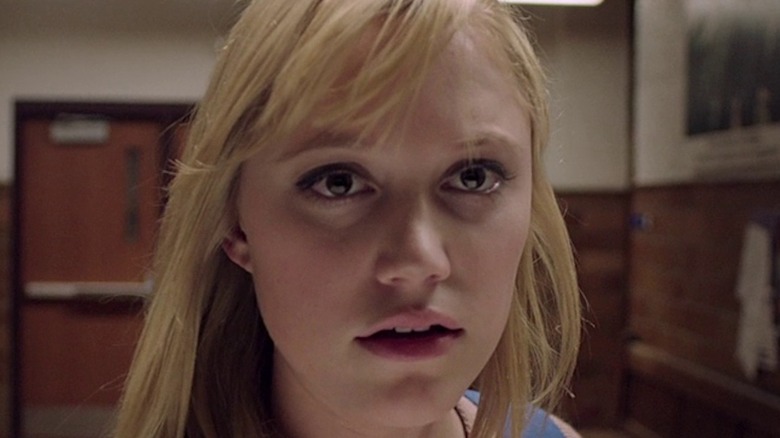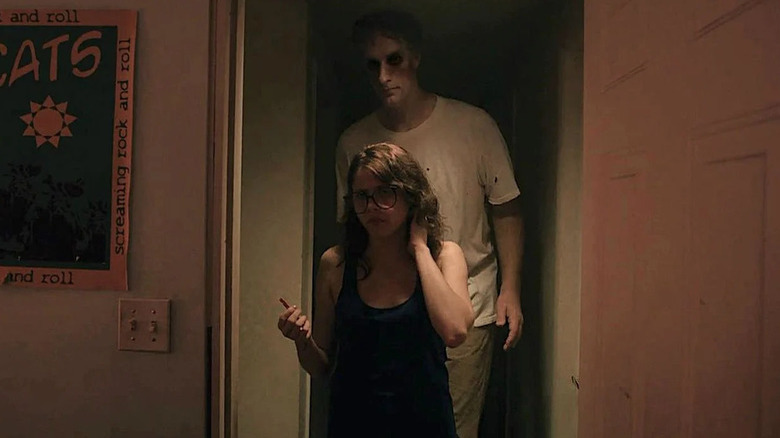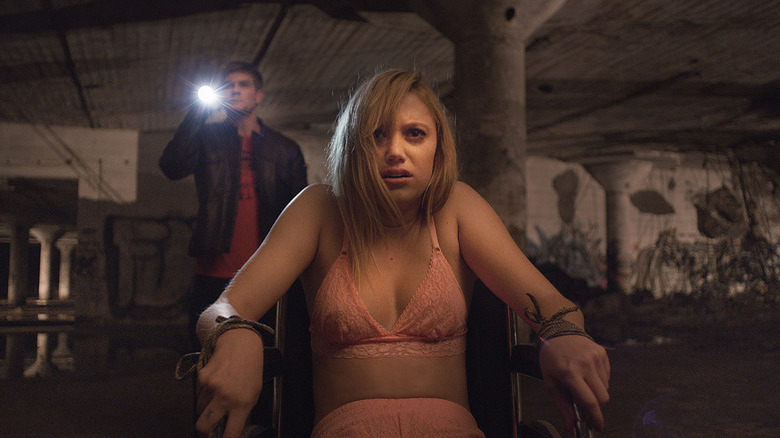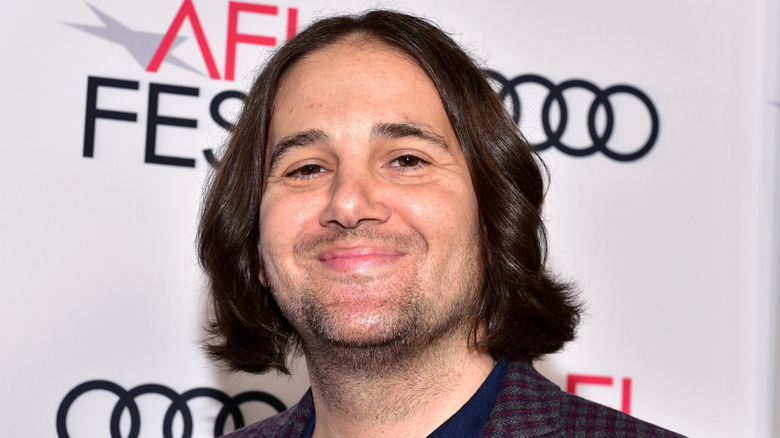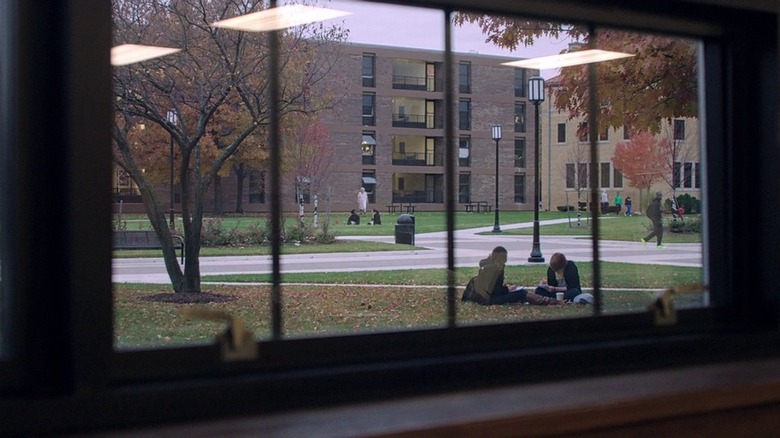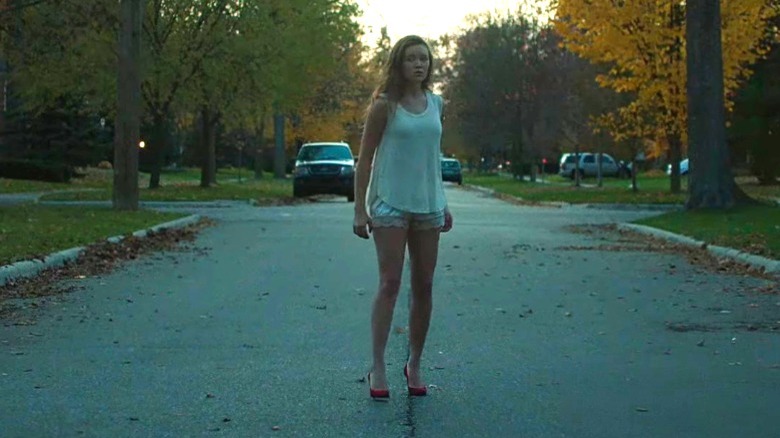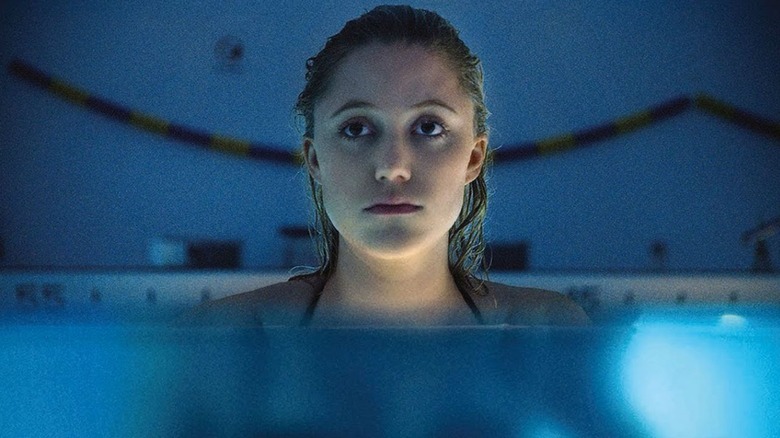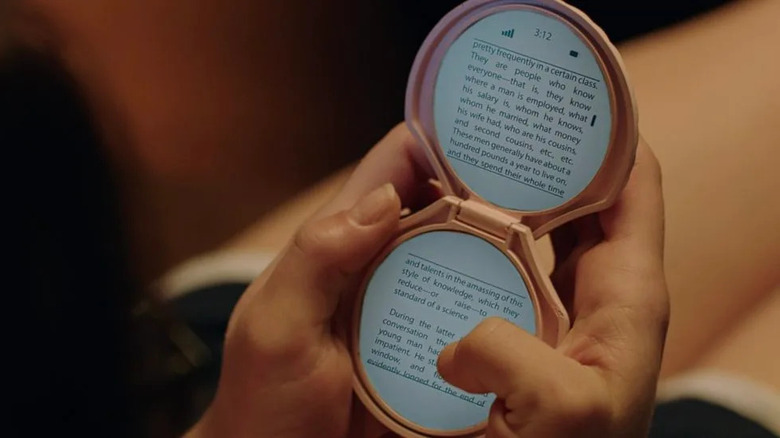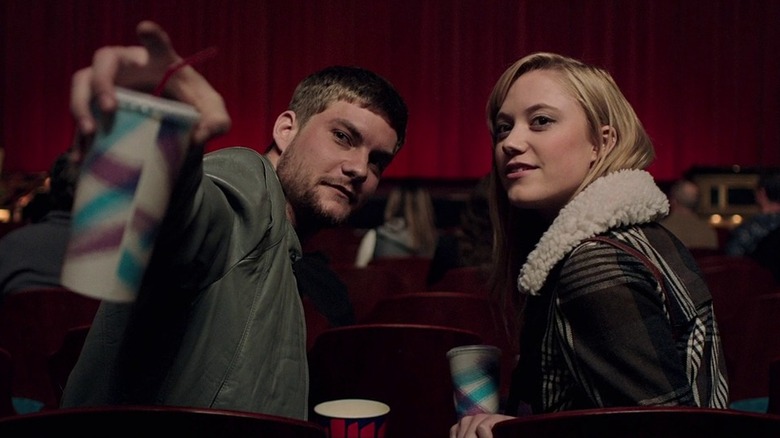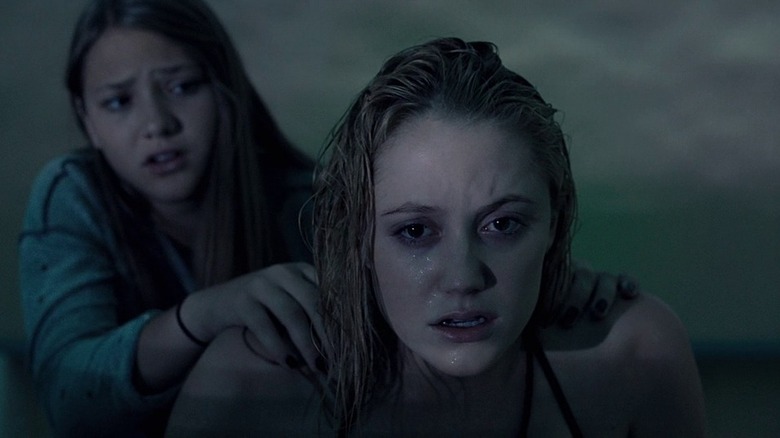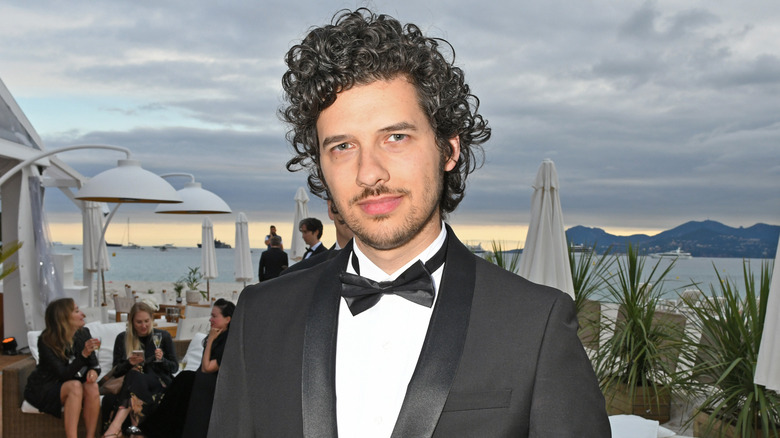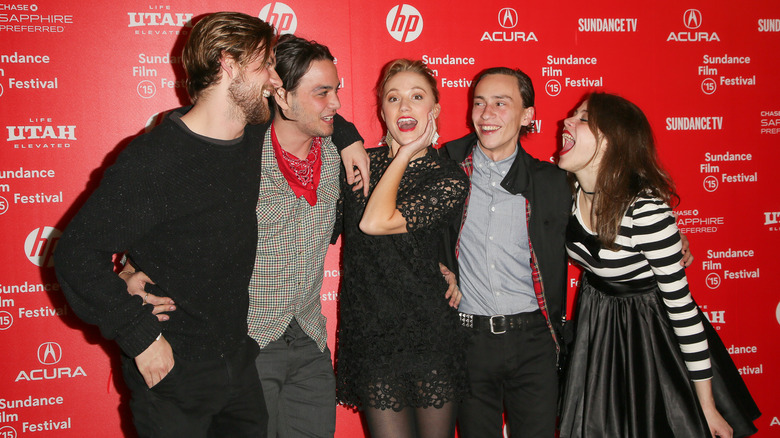The Untold Truth Of It Follows
The monster has no name, but it has many faces. Its origins are unknown, and why it exists in the first place remains a mystery. It might move slowly, but one thing is for certain: It will catch up to you, no matter what. This describes the central premise of David Robert Mitchell's 2015 film "It Follows." Newcomer Maika Monroe – now a bonafide scream queen – plays Jay, a young woman who starts being haunted by a number of eerie figures after having sex with her boyfriend. She learns that whatever this mysterious curse is, it's passed through sexual intercourse, and the only way she can get rid of it is by having sex with someone else.
"It Follows" is the kind of film that's hard to put into words. On paper, it doesn't sound all that scary. Someone following you around at a reasonable pace? Doesn't really seem like a recipe for jaw-dropping horror. And yet, it is. "It Follows" is the kind of film that gets under your. With Mitchell's deft directorial hand, the film becomes more than the sum of its parts.
As a fairly understated horror movie, you could be tricked into thinking the production process wasn't all that complicated. But, like most films, there's more than meets the eye. Curious about what went into the making of the film? You've come to the right place. Keep reading to discover the untold truth of "It Follows."
The concept was based on the director's recurring nightmare
We don't envy David Robert Mitchell's psyche. Every film has an origin story, and for the "It Follows" director, it came straight from the director's subconscious. Speaking with The Austin Chronicle, Mitchell explained that the initial idea for the film came from a recurring nightmare he used to have as a child. "I was followed by this monster that could look like other people. It walked very slowly, and was coming from a long ways away. I could always get away from it — I ran or climbed out a window or whatever — but it was a terrible feeling," he said.
Mitchell said that he's learned since then that it's actually a fairly common anxiety dream. He told Digital Spy that it likely had something to do with the things that were going on in his life during that period, as his parents were going through a divorce around that time. He explained that he still remembers specific moments from the dream and though he didn't exactly mirror these moments in the film, the feelings that the dream awoke in him served as an inspiration.
As for the sexual component of the film, that idea came much later, when he was considering how to flesh out story of "It Follows." As he told Yahoo, "I thought that it would be nice to have [the monster] be something that can move between people. It just sort of made sense to me that if it was something that was passed through sex it would be a way to link the characters — to connect them both physically and emotionally."
The director didn't have to push Maika Monroe to give a great performance
Director David Robert Mitchell told Digital Spy that the casting process for the film was pretty typical and it was obvious that lead actress Maika Monroe was perfect for the part when she auditioned. When it came time to shoot the film, Mitchell explained that Monroe made his job as a director easy. "In terms of performance I didn't have to push her. She is more than capable of bringing herself to that place," he said.
Mitchell said that while they had many discussions about the character and the overall tone of the film, by the time the camera started rolling, she was totally in the zone. The shoot was a difficult one, especially when you consider the final scene, which required Monroe to be in the water for a long period of time. But, according to Mitchell, she was strong enough to handle anything that was thrown her way.
In many ways, it's Monroe's performance that carries the film. Mitchell concurs. "There was a vulnerability that was needed and she has that. She was able to convey that and that's what keeps the film from going into B-movie territory," he told Slant Magazine.
Shooting the film was an intense process for Maika Monroe
"It Follows" star Maika Monroe knew she wanted to be a part of the film, but she wasn't quite prepared for how grueling the shoot would be. She told HeyUGuys that it was difficult to remain in her character's headspace all of the time, so she spent a lot of time on her own listening to sad music in between takes.
The environment in which they shot the film didn't make the experience any easier. Production took place in Detroit, but rather than it being summertime like it is in the film, they shot in the dead of winter. "It was, you know, freezing every day, and of course David wants it to be summer so we're in tank tops and shorts and it's, you know, 32 degrees outside," Monroe noted. Though she called the shooting process "physically and mentally exhausting," she maintained that it was all worth it for the final product.
There's also the matter of what her character goes through in the film. Monroe told Den of Geek that portraying the horror Jay experiences was difficult because she had never gone through anything like that kind of terror in her life. She had to draw from outside of her own life to embody Jay, explaining, "Running, screaming for my life, frightened I'm going to be murdered, that all has to be your imagination."
The director avoided describing what the film was about while he was developing it
Telling your friends why they should go and watch "It Follows" can be a difficult task. On paper, it doesn't sound all that interesting or shocking. Director David Robert Mitchell understands this problem better than anyone. Speaking with Yahoo, Mitchell agreed that "you can't really describe it. When you say it out loud, it sounds like the worst thing ever."
Collider asked Mitchell if he had an elevator pitch for the film, and he responded that "there wasn't one and the reason is because any elevator pitch for this would be just terrible." For this reason, he avoided talking to people about the film in any detail. "Personally, I couldn't pitch this to anybody," he explained. "And when people would ask me what I was doing, I'd be like, 'It's a horror film.' 'What is it about?' 'You'll just have to see it.'"
When it came time to find collaborators for the film, he found that the best course of action was to send them the entire script. He also had a "lookbook" for the film that he showed potential collaborators, which was a helpful tool for getting people to understand what the tone of the film would be. It's the kind of movie that you have to see to believe, and luckily for Mitchell, the final product is a lot more interesting than an elevator pitch could ever express.
The film was shot in a way that keeps the audience on the edge of their seat
Maika Monroe's performance is one of the key aspects of the film's success, but the way the "It Follows" is shot is just as important. The film uses two filmmaking techniques — wide angle shots and long takes — to achieve its eerie, spine-tingling tone. Speaking with Yahoo, director David Robert Mitchell explained how the camera was used to create this immersive feeling. "It was about placing the viewer and the audience within the world," he said. This meant that the pacing was slower than you might expect and the takes were as long as they could be.
Mitchell told Complex that "The film's designed to say, "We're not going to tell you every time that something dangerous is in the frame or is approaching," and once you know that, you will start to look." This visual language has the effect of training the audience to look around the frame in every scene, as they begin to expect that something is lurking just around the corner. "You'll then do that the whole time, and the dread builds from that," Mitchell explained.
The use of wide-angle lenses allowed Mitchell to accomplish this goal more effectively, as it increases the depth of field and makes the background more visible. Rather than move the camera in order to track the creature's movements, the creature instead creeps into the frame, an effect that is arguably more chilling.
The opening sequence of the film is one long take
The opening shot of "It Follows" is an extremely effective sequence, and it's hard not to be immediately enthralled by the film from this moment on. The film begins with a slow pan that depicts a young woman running out of the house in fear. We don't know exactly she's running from at this point. As she runs into the middle of the street, we see that she's wearing high heels, which David Robert Mitchell told The New York Times was "a play on the conventions of horror" and an homage to the women of Brian De Palma movies
The scene is done in one long shot, as the camera pans in a circle around the street, tracking the young woman as she moves. The camera movements have a significant effect on how the audience engages with the film. As Mitchell explained, "it's playing on this idea of us being sort of colder observers of this terrible thing happening, that we're on the outside of it."
It may look easy, but it took a lot of effort to pull off this shot. "It Follows" cinematographer Michael Gioulakis told Definition Magazine that there wasn't enough money in the budget for a remote controlled camera head, so he and his crew had to chase around the actress with the dolly, as they shot the 360 degree pan. They rehearsed the scene a few times while the sun was still in the sky, and were able to squeeze in a few good takes before the light disappeared entirely.
There were several iconic filmmakers who inspired the film
Most filmmakers have directors who inspire their work, and for "It Follows" director David Robert Mitchell, it's no different. Unsurprisingly, like most horror directors, Mitchell is a big fan of horror legend John Carpenter, as he told The AV Club. While there aren't specific moments in "It Follows" that Mitchell saw as homages to Carpenter, he did note that he is "a fan of his blocking and his staging and his compositions" and since he's seen his work so much, it's perhaps inevitable that subconscious nods to Carpenter would appear in "It Follows."
Mitchell also described his love for David Cronenberg and Brian De Palma, filmmakers whose influences can be seen in his work. Hitchcock's "Rear Window" is an all-time favorite, and he's also a big fan of the 1954 classic "Creature From The Black Lagoon." Mitchell told Birth Movies Death that one of the ideas he took from "Black Lagoon" is that feeling of waiting for the creature to pop up, and that while he might move slowly on land, he's very persistent. "Island of Terror" was also an inspiration in this regard.
Though most of Mitchell's inspirations don't show up as direct references in the film, there is one shot that is an intentional homage. He told Yahoo that "The idea of a character being isolated in a pool, being stalked by something, is a direct reference to Cat People." Apart from that one scene near the end of "It Follows," the shots all came from the creative minds of Mitchell and his team.
The director sees the movie as a dream, not as a reflection of reality
You might not notice it at first, but the setting of "It Follows" is pretty ambiguous. There are a few moments where we see modern pieces of technology, but the characters in the film are often watching movies in black and white, and even the cars have a vintage look to them. The teenage characters don't speak in pop culture references, nor does their dialogue feel overly modern.
This ambiguity was intentional. Director David Robert Mitchell told The AV Club that this element of timelessness comes from his personal filmmaking philosophy. "The ground rules of the film world don't have to be how we understand the world," he explained. "Movies are very much dreams, in a way, and you can use that to your advantage."
This philosophy is evident in the film's production design. There are some elements of the production design that date back to the 1950s, while some of it is contemporary. Some of it is entirely made-up, such as the "shell phone" that is used as an e-reader in the film. Mitchell was bothered by the notion that using recognizable smartphones in a film automatically ties it to a specific year or time period, and he didn't want that. "And all of that is really just to create the effect of a dream—to place it outside of time, and to make people wonder about where they are," he explained. Oddly enough, this approach of "It Follows" may have inspired the series "Riverdale," according to Cole Sprouse.
There is no real answer as to where It comes from
In certain horror movies, a great deal of effort is made to explain the supernatural phenomena that occur. While this type of logical reasoning might be satisfying to some, it's not always necessary in the creation of a truly unsettling horror movie. For example, in "It Follows," it's never clear what exactly the monster is, what it wants, or where it originally came from.
For director David Robert Mitchell, it was important that the exact nature of the entities remain ambiguous. "I'm not personally that interested in where 'it' comes from," he told Digital Spy. It all boils down to his philosophy that films should be viewed as dream-like exercises rather than reflections of reality. "To me, it's dream logic in the sense that they're in a nightmare, and when you're in a nightmare there's no solving the nightmare. Even if you try to solve it," he explained. So if you're looking for a concrete explanation, you're not going to get one. And that's exactly the way Mitchell intended it to be.
The movie didn't seem scary while they were shooting it
One of the most interesting things about the production of horror movies is how different the shooting process is from the final product. In some cases, there are special effects that aren't put into place until post-production, which means the actors can't actually see the thing they're meant to be afraid of. In the case of "It Follows," there were very few special effects involved, but the experience of shooting the film wasn't very scary at all.
Speaking with Complex, David Robert Mitchell explained that this was one of the challenges of the film. "You have to constantly remind yourself about the accumulated tone and anxiety that the audience will have once the movie is all put together," he said. "The images of people walking are only scary when they're seen within the movie's full context, you know?"
The eerie tone of "It Follows" is one of the things that makes the film so haunting, but the sense of dread you get while watching the film wasn't something the cast and crew felt while on set. Even after the film was completed, Mitchell still couldn't experience the horror of the film the way the audience does. "I'm too close to it. I can't feel that. It doesn't scare me," he told Collider. Luckily, Mitchell was able to screen the film for people before it was released, which gave him a sense of how frightening it really was.
The film's score was done by a video game composer
It's an indisputable fact that the score is one of the most important elements of a horror movie. Haven't you ever covered your ears when something gets too suspenseful? Without sound, it's just not the same. "It Follows" director David Robert Mitchell was well aware of this fact, and he had a specific composer in mind to work on his film. He knew from the beginning that he wanted an electronic score for the film, so he reached out to Rich Vreeland, a composer who goes by the name Disasterpeace.
Disasterpeace had only worked on video games before working with Mitchell, but he was willing to try something new. Mitchell told Complex that he was looking for music "that could be beautiful and melodic in some places and then also an assault." Disasterpeace delivered on the brief, and as Mitchell described it, "the score borders on being assaultive noises in some places." Disasterpeace worked around the clock to complete the score, and it was finished in an amazingly short period of just three weeks.
Disasterpeace told Vice that the short turnaround time was quite stressful, "but one of the things that helped with that was that the director and his editors put together a temp score for the film that had reference material from people like John Carpenter, John Cage, [Krzysztof] Penderecki, and also music from Fez [the video game he composed for] as well."
The cast weren't sure the movie was going to work at first
"It Follows" is the kind of movie that is hard to imagine from reading the script alone, so we don't blame the film's cast for being hesitant to accept their roles at first. In an interview with Upbeat Entertainment, Daniel Zovatto, who plays Greg, described his first reaction upon reading the script. "I thought it was completely nuts, and I didn't think that this could be a movie that people actually wanted to go and watch," he said. He didn't think there was anyone who could pull off such an ambitious script, but then he watched David Robert Mitchell's previous film, "The Myth of the American Sleepover," and he was convinced Mitchell was the man for the job.
Maika Monroe had a similar journey. She told HeyUGuys that she thought the script was bizarre, but she was intrigued enough to send in an audition tape. She wasn't sure how the script could be transformed into a film, but she met with Mitchell to discuss it. Like Zovatto, she was finally convinced when she watched "The Myth of the American Sleepover," which she described as "so different and unique, I've never seen anything quite like it." At this point, Monroe began imagining what "It Follows" could become in Mitchell's hands.
